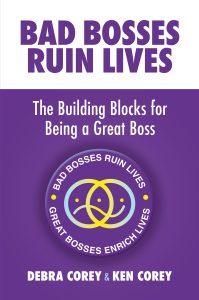By Debra Corey and Ken Corey, below
 When we think of bad bosses we conjure up images of cartoon characters with steam coming out of their ears or in movies screaming at their poor, defenceless employees. And while these stereotypical bad bosses do exist, the reality is that many other types and traits exist in the real workplace, far beyond the caricature we see in cartoons or Hollywood.
When we think of bad bosses we conjure up images of cartoon characters with steam coming out of their ears or in movies screaming at their poor, defenceless employees. And while these stereotypical bad bosses do exist, the reality is that many other types and traits exist in the real workplace, far beyond the caricature we see in cartoons or Hollywood.
In fact, in our book Bad Bosses Ruin Lives: The Building Blocks for Being a Great Boss, we identified and explored 10 very real and very common types of bad bosses. They reflect the wide variety of traits that exist in many bosses that cause and lead them to act in ways that negatively impact their people and, ultimately, their company.
As research for our book, we conducted a survey that asked people which of the 10 types of bad bosses they’ve had during their time in the workplace. The results were overwhelmingly consistent (and shocking), with 99.6% of respondents saying that they’ve had a boss who exhibits some or all of the traits of at least one of the 10 bad boss types. We also found that for every one of the 10 types, more than 50% of respondents said they’ve had a boss like this.
The most common types of bad bosses
So, which of these 10 types of bad bosses are the most common? Here are the top three we found in our survey:
 The Unappreciater – This was the most common type of bad boss, with 81% of respondents saying they’ve had a boss exhibiting some or all of the traits of this kind of boss. They include not showing their people recognition, gratitude, or appreciation, making them feel unvalued, invisible, and unappreciated for their actions and contributions.
The Unappreciater – This was the most common type of bad boss, with 81% of respondents saying they’ve had a boss exhibiting some or all of the traits of this kind of boss. They include not showing their people recognition, gratitude, or appreciation, making them feel unvalued, invisible, and unappreciated for their actions and contributions.
The problem with this is if a boss holds back appreciation, they’re missing out on powerful moments to capture and celebrate the good and great work and contributions that their people are making. They’re leaving them scratching their heads and wondering if what they’ve done is right, is good enough, or seen in the first place. For this reason, delivering what I call the “appreciation feeling” drives awareness, productivity, profit, wellbeing, and a myriad of other positive results for your people and your business.
 The Micromanager – This type of bad boss was slightly below the last, with 80% of respondents saying they’ve had a boss exhibiting some or all of these traits. These include being overly involved in their people’s work, constantly controlling and prescribing what and how work is done. This often happens because the boss believes their people want and need this from them. However, this is far from the truth, as nothing can be more demotivating and exhausting than having a boss like this. Because yes, a micromanager is there for their people, but at what cost? For instead of giving them the time, space, and autonomy to perform, their excessive control and involvement often squash the joy and meaning out of their people’s work, leaving them resentful, resistant, and frustrated.
The Micromanager – This type of bad boss was slightly below the last, with 80% of respondents saying they’ve had a boss exhibiting some or all of these traits. These include being overly involved in their people’s work, constantly controlling and prescribing what and how work is done. This often happens because the boss believes their people want and need this from them. However, this is far from the truth, as nothing can be more demotivating and exhausting than having a boss like this. Because yes, a micromanager is there for their people, but at what cost? For instead of giving them the time, space, and autonomy to perform, their excessive control and involvement often squash the joy and meaning out of their people’s work, leaving them resentful, resistant, and frustrated.
 The Avoider – This type of bad boss again had 80% of respondents saying that they’ve had a boss exhibiting some or all of these traits. As the name implies, these traits include avoiding their people by not showing up for and ghosting them, not giving them the time, attention, and feedback they need to do their job and feel valued. They do this in two distinct but related ways, both having to do with the concept of avoidance and shutting people out (think of a door, physical or virtual). The first relates to time, being a ghost to their people through avoidance or lack of visibility. The second relates to attention, not giving their people the attention and support they need and avoiding giving them feedback. We’re seeing this more and more as new work patterns and arrangements like hybrid, remote, and flexible working emerge, making it harder for bosses to connect and support their people, but more important than ever.
The Avoider – This type of bad boss again had 80% of respondents saying that they’ve had a boss exhibiting some or all of these traits. As the name implies, these traits include avoiding their people by not showing up for and ghosting them, not giving them the time, attention, and feedback they need to do their job and feel valued. They do this in two distinct but related ways, both having to do with the concept of avoidance and shutting people out (think of a door, physical or virtual). The first relates to time, being a ghost to their people through avoidance or lack of visibility. The second relates to attention, not giving their people the attention and support they need and avoiding giving them feedback. We’re seeing this more and more as new work patterns and arrangements like hybrid, remote, and flexible working emerge, making it harder for bosses to connect and support their people, but more important than ever.
So what about the other types of bad bosses? Here are how the other seven types scored in the survey in order of prevalence: Ignorer (78%), Firefighter (77%), Coercer (72%), Blamer (68%), Blocker (65% and Pretender (51%). For more details on our survey, go to https://www.badbossesruinlives/resources, and download a free report.
Moving forward
Where do you go from here? What do you do about the bad bosses you may have at your company? Here are three tips you can share with your bosses, helping them all be great:
- Be aware of any bad boss traits you may have – The truth is that there are bad boss traits in all of us, not just the few. Understanding what they are is important so you can accept those that apply to you instead of denying that they exist.
- Understand that you’re not either a bad, good, or great boss – When it comes to being a boss, it is never either/or, all, or nothing. We all have a mix of traits, some bad, some good, and some great. The reality is that there are shades of grey. They come and go based on the situation, the person, and even what’s happening in our lives. The key is understanding what they are and how you can deal with and improve them.
- Equip yourself with new skills to be great – You need to equip yourself with new skills so you’re able to tackle your bad boss traits instead of trying to be a great boss using bad boss techniques and approaches. You need to walk into them and not away from them!
If you or your team want to learn more about your boss traits (good, bad or great), feel free to take our free and confidential online assessment at https://www.badbossesruinlives/assessment.
 Debra Corey and Ken Corey are experts in HR and people development, and the authors of Bad Bosses Ruin Lives: The Building Blocks for Being a Great Boss.
Debra Corey and Ken Corey are experts in HR and people development, and the authors of Bad Bosses Ruin Lives: The Building Blocks for Being a Great Boss.

